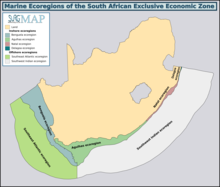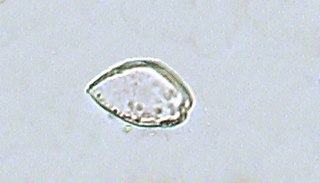

This is a list of red seaweeds (Domain: Eukaryota, Division: Rhodophyta) recorded from the oceans bordering South Africa. This list comprises locally used common names, scientific names with author citation and recorded ranges. Ranges specified may not be the entire known range for the species, but should include the known range within the waters surrounding the Republic of South Africa.
Contents
- Class: Bangiophyceae
- Order: Bangiales
- Order: Porphyridiales
- Class: Compsopogonophyceae
- Order: Erythropeltidales
- Class: Florideophyceae
- Order: Acrochaetiales
- Order Balliales
- Order Bonnemaisoniales
- Order Ceramiales
- Order Colaconematales
- Order Corallinales
- Order Gelidiales
- Order Gigartinales
- Order Gracilariales
- Order Halymeniales
- Order Hildenbrandiales
- Order Nemaliales
- Order Nemastomatales
- Order Palmariales
- Order Peyssonneliales
- Order Plocamiales
- Order Rhodymeniales
- Class Rhodophyta incertae sedis
- Order Rhodophycophyta incertae sedis
- Class: Stylonematophyceae
- Order: Stylonematales
- See also
- Geographical position of places mentioned in species ranges
- References
List ordering and taxonomy complies where possible with the current usage in Algaebase, and may differ from the cited source, as listed citations are primarily for range or existence of records for the region. Sub-taxa within any given taxon are arranged alphabetically as a general rule. Details of each species may be available through the relevant internal links. Synonyms may be listed where useful.
Red algae , or Rhodophyta ( /roʊˈdɒfɪtə/ , /ˌroʊdəˈfaɪtə/ ; from Ancient Greek ῥόδον (rhódon) 'rose',and φυτόν (phutón) 'plant'), are one of the oldest groups of eukaryotic algae. The Rhodophyta comprises one of the largest phyla of algae, containing over 7,000 currently recognized species with taxonomic revisions ongoing. The majority of species (6,793) are found in the Florideophyceae (class), and mostly consist of multicellular, marine algae, including many notable seaweeds. Red algae are abundant in marine habitats but relatively rare in freshwaters. Approximately 5% of red algae species occur in freshwater environments, with greater concentrations found in warmer areas. Except for two coastal cave dwelling species in the asexual class Cyanidiophyceae, there are no terrestrial species, which may be due to an evolutionary bottleneck in which the last common ancestor lost about 25% of its core genes and much of its evolutionary plasticity.
The red algae form a distinct group characterized by having eukaryotic cells without flagella and centrioles, chloroplasts that lack external endoplasmic reticulum and contain unstacked (stroma) thylakoids, and use phycobiliproteins as accessory pigments, which give them their red color. But despite their name, red algae can vary greatly in color from bright green, soft pink, resembling brown algae, to shades of red and purple, and may be almost black at greater depths. Unlike green algae, red algae store sugars outside the chloroplasts as floridean starch, a type of starch that consists of highly branched amylopectin without amylose, as food reserves outside their plastids. Most red algae are also multicellular, macroscopic, marine, and reproduce sexually. The life history of red algae is typically an alternation of generations that may have three generations rather than two. The coralline algae, which secrete calcium carbonate and play a major role in building coral reefs, belong here. Red algae such as Palmaria palmata (dulse) and Porphyra species (laver/nori/gim) are a traditional part of European and Asian cuisines and are used to make other products such as agar, carrageenans and other food additives. ( Full article... )






